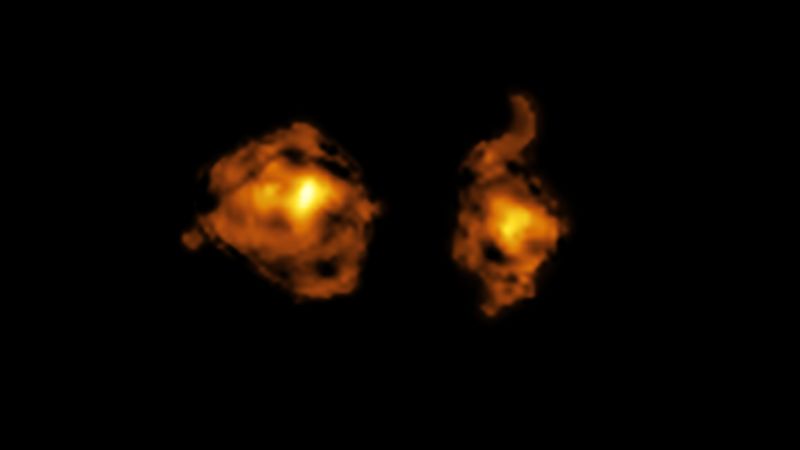Astronomers have recently made a groundbreaking discovery in the field of astrophysics: they have observed two galaxies engaged in a dynamic “duel” over vast cosmic distances, marking a significant addition to our understanding of galactic interactions. The findings, made possible through nearly four years of combined observations using an array of ground-based telescopes, illustrate a dramatic encounter between these distant galactic neighbors hurtling towards each other at an astounding speed of over 1.1 million miles per hour (1.8 million kilometers per hour). This intense interaction is characterized by one galaxy emitting powerful beams of radiation that are disrupting gas clouds in the second galaxy and hampering its capacity to create new stars.
The lead researcher of this study, Pasquier Noterdaeme from the Paris Institute of Astrophysics and the French-Chilean Laboratory for Astronomy, aptly termed this cosmic phenomenon as a “cosmic joust.” The observations reveal a snapshot of these two galaxies merging into one large entity, located an impressive 11 billion light-years away. The implications of this research, published in the journal *Nature*, provide an invaluable glimpse into a period in the universe when galaxy mergers and star formation were much more prevalent.
Utilizing the Very Large Telescope (VLT) operated by the European Southern Observatory, in conjunction with the Atacama Large Millimeter/submillimeter Array (ALMA) located in Chile, scientists were able to unravel the mysteries of this dynamic interaction. The researchers found that the radiation coming from the “attacking” galaxy is emitted from a luminous quasar at its core, a bright entity powered by a supermassive black hole. According to NASA, the gravitational forces exerted by such black holes attract material at extreme velocities, leading to heating in excess of millions of degrees. This creates luminous accretion disks and results in the emission of jets of energetic matter directed away from the black hole.
The findings highlight that the quasar’s ultraviolet radiation is incredibly potent, being approximately a thousand times more intense than the sunlight emitted by our own Milky Way galaxy. This extreme radiation causes hydrogen molecules from the “victim” galaxy’s star-forming regions to become dispersed and fragmented, which is of particular significance since star formation occurs when dense clumps of gas and dust collapse under their own gravitational forces. However, the study noted that this radiation has rendered the clouds too diffuse to form new stars.
As matter from the victim galaxy is pulled closer to the supermassive black hole, it supplies additional energy to the quasar, creating a cycle of increased radiation and potential disruption of star formation. One of the study’s co-authors, Sergei Balashev from the Ioffe Institute in St. Petersburg, Russia, remarked that quasars can intermittently “switch off,” which could permit the molecular clouds an opportunity to regroup and retain their ability to form stars.
This pioneering observation provides the first confirmed evidence directly illustrating the quasar’s influence on the molecular gas within a neighboring galaxy. Previously, such effects had only been theorized. This insight emerged from the team’s focus on this specific quasar, which exhibited distinctive features among many low-resolution spectra observed, akin to a celestial fingerprint offering clues about its composition, activity, and temperature.
Only about 1,000 dynamic and luminous quasars are known from the early universe, as highlighted by Anniek Gloudemans, a postdoctoral fellow at the National Science Foundation’s NOIRLab. The research team noted that while they had initially identified some molecular gas between the quasar and Earth, it wasn’t until they examined with larger telescopes that they discerned the presence of two colliding galaxies.
Through high-resolution imaging from ALMA, the researchers identified that, despite appearing merged in low-resolution spectra, these galaxies are actually separated by thousands of light-years. The light captured by these instruments offers a look back in time, indicating that the merger may already have occurred millions of years ago, though this remains uncertain.
Astrophysicists like Dong-Woo Kim from the Harvard and Smithsonian Center for Astrophysics indicate that galaxy mergers and quasars were likely much more prevalent in the universe’s earlier epochs, when gravitational forces drew galaxies closer together. As the universe expanded, more galaxies fused into larger formations, which showcases a fascinating evolution of cosmic order.
As Noterdaeme expressed, the universe approximately 10 billion years ago was a vibrant time for star formation, often referred to in astronomy as the “noon of the universe.” While galaxy mergers may be less frequent now, they still occur. In fact, our Milky Way is predicted to collide with the Andromeda galaxy in a few billion years. Nonetheless, the commonality of the “cosmic joust” phenomenon during such mergers remains an intriguing area for future research. The study’s findings pave the way for deeper investigations into galaxy formation and evolution, underscoring the excitement and potential for discoveries in the field of astrophysics.



